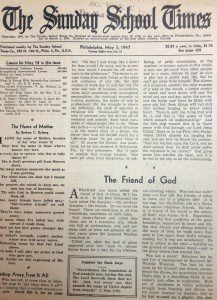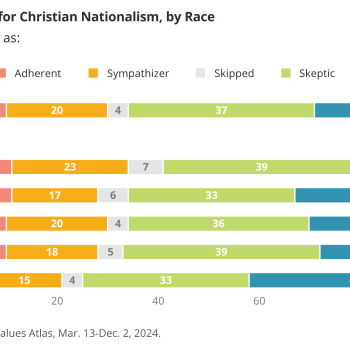 After twenty-one years of marriage, my wife and I know each other pretty well. We are in that stage of our relationship where we often know what the other person is thinking in a conversation with a third party and can, at times, finish each other’s sentences. Often, we find ourselves exclaiming, “that’s exactly what I was thinking!” Yet, my wife still regularly surprises me with some unknown childhood anecdote or an opinion on a particular topic. To me, those moments of surprise are a lot of fun. Likewise, part of the joy of historical research comes in discovering things about your subject(s) that surprise you, particularly when researching a subject where you have a good feel for the overarching narrative and accepted historiographical interpretations. (I have written on historical surprise here, and in this post, Tommy Kidd pointed us to Edmund Morgan’s thoughts on “surprise.”)
After twenty-one years of marriage, my wife and I know each other pretty well. We are in that stage of our relationship where we often know what the other person is thinking in a conversation with a third party and can, at times, finish each other’s sentences. Often, we find ourselves exclaiming, “that’s exactly what I was thinking!” Yet, my wife still regularly surprises me with some unknown childhood anecdote or an opinion on a particular topic. To me, those moments of surprise are a lot of fun. Likewise, part of the joy of historical research comes in discovering things about your subject(s) that surprise you, particularly when researching a subject where you have a good feel for the overarching narrative and accepted historiographical interpretations. (I have written on historical surprise here, and in this post, Tommy Kidd pointed us to Edmund Morgan’s thoughts on “surprise.”)
 Several weeks ago, I put the finishing touches on my paper, “Coloring the Young People’s Prayer Meeting: The Sunday School Times and the Challenge of Mid-Century “’Race Relations,’” which I will present at the Conference on Faith & History in Malibu, CA later this week. (More on the conference here and here.) Recently, as I prepared my oral presentation, I reflected on several revelations which surprised me when I first came across them. In particular, it surprised me to learn that the Federal Council of Churches, a decidedly “mainline” (i.e. not fundamentalist) organization, influenced the content of The Sunday School Times, a decidedly fundamentalist (i.e. not “mainline”) weekly publication, during the 1940s and 1950s, albeit through a meandering route.
Several weeks ago, I put the finishing touches on my paper, “Coloring the Young People’s Prayer Meeting: The Sunday School Times and the Challenge of Mid-Century “’Race Relations,’” which I will present at the Conference on Faith & History in Malibu, CA later this week. (More on the conference here and here.) Recently, as I prepared my oral presentation, I reflected on several revelations which surprised me when I first came across them. In particular, it surprised me to learn that the Federal Council of Churches, a decidedly “mainline” (i.e. not fundamentalist) organization, influenced the content of The Sunday School Times, a decidedly fundamentalist (i.e. not “mainline”) weekly publication, during the 1940s and 1950s, albeit through a meandering route.
During the 1940s and 1950s, The Sunday School Times (SST) ran a regular feature entitled “The Young People’s Prayer Column.” Each week, the column provided commentary on Young People’s Society for Christian Endeavor’s “uniform lesson plan,” written to guide the Bible study portion of the Sunday Night Weekly Prayer Meeting of local chapters of Christian Endeavor. Founded in 1881, Christian Endeavor embraced the small group approach of many evangelical ministries of the past in order to reach young people. Members agreed to regularly attend Sunday night meetings, participate in spiritual disciplines, and evangelize those who were not Christians.

During the first two decades of the twentieth century, Christian Endeavor’s founder, Francis Clarke embraced the efforts of the Sagamore Sociological Conference (SSC). Founded by a Northern Baptist layman who also served as the publisher for The Christian Endeavor World, the SSC brought academics, ministers, and laypeople to Sagamore Beach, Cape Cod to discuss the application of Christianity to the social issues of the day. Both Josiah Young and Walter Rauschenbusch endorsed their efforts.
By the 1940s, the editors of the conservative Sunday School Times felt comfortable enough with Christian Endeavor’s evangelical bona fides to support its program by providing commentary on its uniform lesson each week. Like other commentary on Bible lessons printed in the SST, commentary on Endeavor’s lessons ran two weeks ahead of when the lessons were slated to be taught.
Like most evangelical publications at mid-century, the editors of the SST times preferred to avoid the thorny question of African American equality during the 1940s and 1950s. By contrast, due in part to the efforts of the Sagamore Sociological Conference, Christian Endeavor came to see improving “race relations” as part of its mission in discipling young men and women. In this arena, they followed the lead of the Federal Council of Churches (FCC).
Beginning in 1923, the Commission on the Church and Race Relations of the FCC had designated the second Sunday in February as Race Relations Sunday. Soon after, Christian Endeavor followed suit. Thus, by the mid-1940s, the FCC’s decision to declare the Sunday before Lincoln’s birthday “Race Relations Sunday” meant that the “Young People’s Prayer Meeting” column would have to address that issue each February. Thus, through a circuitous route, the FCC’s efforts in the area of “race relations” determined a (very small) portion of the content that appeared in The Sunday School Times each year. If you want to know how the editors of the SST dealt with that “inconvenience,” you will just have to attend my paper in Malibu on Friday. I hope to see you there!
References:
*Clarke, Francis Edward. The Christian Endeavor Manual. Revised Edition. Boston and Chicago: United Society of Christian Endeavor, 1903.
*The Sunday School Times. Volumes 85- 102: 1942-1960.
*Wills, David W. “An Enduring Distance: Black Americans and the Establishment.” In William R. Hutchison, Editor. Between the Times: The Travail of the Protestant Establishment in America, 1900-1960. New York: Cambridge University Press, 1989.)
*White, Ronald C., Jr. Liberty and Justice for All: Racial Reform and the Social Gospel (1877-1925). Louisville, KY: Westminster John Knox Press, 2002.












